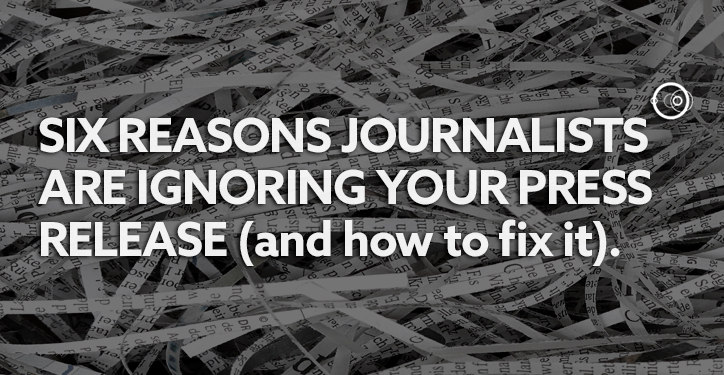It’s frustrating putting a shedload of work into something only to see it not get picked up by anyone. Calls with clients, draft after draft, arranging pictures and then nothing. Not even a centimetre of coverage.
But rather than phone up journalists asking them to give your client some coverage, do we ever sit back and think about what we could have done differently? Having spent nearly 14 years on the receiving end of many a press release in a previous life at a newspaper, I’d like to think I know what constitutes a good piece of work – but I most definitely know what makes up a bad piece.
Here are six reasons why your release might not get picked up:
1. The intro.
Starting an email with Dear XXXX or something like a mis-spelt name can turn the reporter off straight away. If you can’t get the simple details correct then why should they read on and give you the time of day? Being aware of time zones and who is on your distribution list is also important. If you start an email with Good morning when you are sending it to a part of the world which is already thinking about clocking off for the day then you won’t endear yourself to the recipient. But the biggest crime of all comes when you want to be all happy-clappy, smiley-smiley and put something like Happy Friyay! as your intro. Unlike other offices, newsrooms are not a fun place to be at the end of a week. Journalists at daily newspapers are under pressure to fill the pages for Saturday and Monday. They don’t want you rubbing it in their face that you’ll be at the bar by 5.15pm while they are still trying to find a splash for Saturday and something to fill Page 17 for Monday. In short, don’t annoy them. The best way to get past the first hurdle is play it safe. A straightforward Hello, while not the most personal, should do the trick.
2. Get to the point.
Journalists are busy people – don’t lead them on a waltz before you tell them what it is you are actually trying to get them to publish. If you have something important to say, say it. Tell them what it is you are getting in touch about and tell them why it’s a newsworthy story. Don’t leave them with more questions than answers.
3. Give them the right info.
It should be a source of pride that you don’t hear from journalists querying something you have said (unless of course you didn’t want to tell them in the first place), particularly spelling and punctuation. Make sure you have given them all the information they could require, and make sure it’s correct. Ensure names and job titles are right, and if you have said you are attaching something, make sure you have. This is particularly important when it comes to caption details on images. You may know the client well enough to know that Jim is in the grey suit fourth from the left, or Denise is second from the right in the blue jacket, but the journalist won’t. Put a full left-to-right caption on any pictures, including the names of anyone in the shot who isn’t your client. If you don’t know who they are, find out.
4. Appreciate you’re not the most important person in their world.
You may think you are and your client is, but unfortunately you’re not. Sorry to put it so bluntly – it’s called getting to the point. From a reporter’s perspective, follow-up calls are irritating. They will decide whether to use your release, and anything extra you may be able to add in a telephone call should already be in the email or release. However, the follow-up call is important to PR folk. There is always a chance your release has slipped through the system and simply been missed, so what harm can a quick call do? Well, the timing is important. What are the publication’s deadlines? When do they have their daily meetings? Is you phoning just going to annoy them even more? Get the timing right.
5. Know who you are pitching to.
You have to make sure you are 100% certain you are pitching to the right publication. For example, if you are putting out a release about an event taking place, make sure the title you are contacting covers that area. If you are sending a calling notice for an event that is happening hundreds of miles away from where they are, they will ignore your email from the outset. Who knows, they might even end up treating your future messages as spam.
6. Their, there, they’re.
Make sure your work is watertight before sending it over. Put yourself in the journalist’s shoes (you should already know the type of stuff they are looking for) and question your work. Should its have an apostrophe? Am I repeating the same words or phrases over and over? Have I used the right there there? If everything is correct, you can be confident what you are pitching to them is exactly the type of thing they are looking for – something that’s quick and easy for them to flag to their news desk and turnaround. You become a trusted and reliable source for them, and that’s something that’s invaluable on both sides of the divide. Leaving the reporter with as little work as possible means your release stands a far better chance of getting picked up.
Getting it right every time so a journalist picks up your words doesn't come naturally to all of us. Wouldn't life be a whole lot easier if you got the experts to do it for you? Contact us today to see what we can do for you
